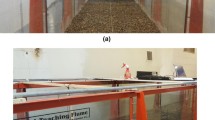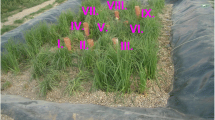Abstract
Discharge of organic waste results in high nutrient pollution of the water bodies which is a major menace to the environment. A high quantity of nutrients such as ammonia causes a reduction in the dissolved oxygen level and induces algal growth in the water bodies. Water quality models have been the tools to evaluate the rate at which streams can disperse the pollutants they receive. Many water quality models are flawed either because of their inadequacy to completely simulate the advection component of the pollutant transport, or because of the limited application of the models, due to inaccurate estimation of model parameters. The hybrid cell in series (HCIS) developed by Ghosh et al. (2004) has been able to overcome such difficulties associated with the mixing cell-based models. Thus, the current study focuses on developing an analytical solution for the pollutant transport of the ammonia concentration through the plug flow, the first and second well-mixed cells of the HCIS model. The HCIS model coupled with the first order kinetic equation for ammonia nutrient was developed to simulate the ammonia pollutant concentration in the water column. The ammonia concentration at various points along the river system was assessed by considering the effects of the transformation of ammonia to nitrite, the uptake of ammonia by the algae, the respiration rate of the algae and the input of benthic source to the ammonia concentration in the water column. The proposed model was tested using synthetic data, and the HCIS-NH3 model simulations for spatial and temporal variation of ammonia pollutant transport were analysed. The simulated results of the HCIS-NH3 model agreed with the Fickian-based advection-dispersion equation (ADE) for simulating ammonia concentration solved using an explicit finite difference scheme. The HCIS-NH3 model also showed a good agreement with the observed data from the Umgeni River, except during rainy periods.








Similar content being viewed by others
References
Agunbiade FO, Moodley B (2014) Pharmaceuticals as emerging organic contaminants in Umgeni River water system, KwaZulu-Natal. South Africa Environ Monit Assess 186:7273–7291
Alam MJ, Islam M, Muyen Z et al (2007) Water quality parameters along rivers. Int J Environ Sci Technol 4:159–167
Aliverdi A, Eslami H (2014) Modelling of BOD and ammonia in Karkheh River using WASP6. Bull Env Pharmacol Life Sci 4:01–09
Ani EC, Hutchins MG, Kraslawski A et al (2010) Assessment of pollutant transport and river water quality using mathematical models. Rev Roum Chim 55:285–291
Anyadike C, Mbajiorgu C, Ajah G et al (2013) Prediction of the physico-chemical interactions of Vimtim stream water quality using the Aquatox model. IOSR J Eng 3:1–6
Banks RB (1974) A mixing cell model for longitudinal dispersion in open channel. Water Resour Res 10:357–358
Bear J (1972) Dynamics of fluids in porous media. American Elsevier publishing company, Inc., New York, p 764
Beer T, Young PC (1983) Longitudinal dispersion in natural streams. J Environ Eng 109:1049–1067
Benedini M, Tsakiris G (2013) Water quality modelling for rivers and streams, Water Science and Technology Library. P 272
Brown LC, Barnwell TO (1987) The enhanced stream water quality models QUAL2E and QUAL2E-UNCAS: documentation and user manual: US Environmental Protection Agency. Office of Research and Development. Environmental Research Laboratory
Chapra SC (2008) Surface water quality modeling. Waveland press
Conley DJ, Paerl HW, Howarth RW, Boesch DF, Seitzinger SP, Havens KE, Lancelot C, Likens GE (2009) Controlling eutrophication: nitrogen and phosphorus. Science 323:1014–1015
Cosgrove W, Rijsberman F (2000) World water vision: making water everybody's business, World Water Council. Earthscan Publications, London
Cox B (2003) A review of currently available in-stream water-quality models and their applicability for simulating dissolved oxygen in lowland rivers. Sci Total Environ 314:335–377
Etemad-Shahidi A, Taghipour M (2012) Predicting longitudinal dispersion coefficient in natural streams using M5′ model tree. J Hydraul Eng 138:542–554
Fischer HB, List EJ, Koh RC, Imberger J, Brooks NH (1979) Mixing in inland and coastal waters. Academic Press, New York, pp 229–242
Gao X, Li G, Zhang C (2015) Modeling the effects of point and non-point source pollution on a diversion channel from Yellow River to an artificial lake in China. Water Sci Technol 71:1806–1814
Genuchten MT, Leij FJ, Skaggs TH et al (2013) Exact analytical solutions for contaminant transport in rivers 1. The equilibrium advection-dispersion equation. J Hydrol Hydromech 61:146–160
Ghosh NC (2001) Study of solute transport in a river. Ph. D thesis, Dept of civ. Eng., IIT. Roorkee, INDIA
Ghosh NC, Mishra GC, Ojha CSP (2004) A hybrid-cells-in-series model for solute transport in a river. J Environ Eng Div ASCE 130:1198–1209
Ghosh NC, Mishra GC, Kumarasamy M (2008) Hybrid-cells-in-series model for solute transport in streams and relation of its parameters with bulk flow characteristics. J Hydraul Eng 134:497–502
Gotovtsev A (2010) Modification of the Streeter-Phelps system with the aim to account for the feedback between dissolved oxygen concentration and organic matter oxidation rate. Water Resour 37:245–251
Gregor J, Maršálek B (2004) Freshwater phytoplankton quantification by chlorophyll a: a comparative study of in vitro, in vivo and in situ methods. Water Res 38:517–522
Jha M, Gu R (2010) Risk analysis of seasonal stream water quality management. Water Sci Technol 62:2075–2082
Kamer K, Fong P, Kennison RL et al (2004) The relative importance of sediment and water column supplies of nutrients to the growth and tissue nutrient content of the green macroalga Enteromorpha intestinalis along an estuarine resource gradient. Aquat Ecol 38:45–56
Kannel PR, Kanel SR, Lee S, Lee YS, Gan TY (2011) A review of public domain water quality models for simulating dissolved oxygen in rivers and streams. Environ Model Assess 16:183–204
Kumarasamy M (2015) Deoxygenation and reaeration coupled hybrid mixing cells based pollutant transport model to assess water quality status of a river. Int J Environ Res 9:341–350
Kumarasamy M, Ghosh NC, Mishra GC et al (2013) Hybrid model development for the decaying pollutant transport in streams. Int J Environ Waste Manag 12:130–145
Kumarasamy M, Mishra GC, Ghosh NC et al (2011) Semianalytical solution for nonequilibrium sorption of pollutant transport in streams. J Environ Eng 137:1066–1074
Kuo JT, Lung WS, Yang CP et al (2006) Eutrophication modelling of reservoirs in Taiwan. Environ Model Softw 21:829–844
Liangliang G, Daoliang L (2015) A review of hydrological/water-quality models. Front Agr Sci Eng 1:267–276
Lin L, Webster J (2012) Sensitivity analysis of a pulse nutrient addition technique for estimating nutrient uptake in large streams. Limnol Oceanogr Methods 10:718–727
María Elena Pérez L, Maria Guadalupe SM, Margarita Teutli L (2013) Eutrophication levels through San Pedro-Mezquital River basin. J Environ Prot
Neuman SP, Tartakovsky DM (2009) Perspective on theories of non-Fickian transport in heterogeneous media. Adv Water Resour 32:670–680
Parsaie, A., Haghiabi, A.H. (2015) Computational modelling of pollution transmission in rivers. Appl Water Sci Pp. 1-10
Rabalais NN, Turner RE, Díaz RJ, Justić D (2009) Global change and eutrophication of coastal waters. ICES J Mar Sci: J Conseil 66:1528–1537
Rahaman MM, Varis O (2005) Integrated water resources management: evolution, prospects and future challenges. Sustain Sci Pract Policy 1:1–9
Rakib Z, Barber M, Mahler R (2015) Modelling flow, nutrient and dissolved oxygen concentrations in the Spokane River under multiple year conditions. WIT Trans Ecol Environ 196:127–138
Rode M, Klauer B, Petry D et al (2008) Integrated nutrient transport modelling with respect to the implementation of the European WFD: the Weisse Elster case study, Germany. Water SA 34:490–496
Schütze M, Reussner F, Alex J (2011) SWQM–a simple river water quality model for assessment of urban wastewater discharges. Proc. 11th International Conference on Urban Drainage (11ICUD). Pp. 11-15
Seibel BA (2011) Critical oxygen levels and metabolic suppression in oceanic oxygen minimum zones. J Exp Biol 214:326–336
Shao-Chen S, Zu-Hao Z, Wei-Hua X et al. (2014) Impact analysis on water quality of the second Songhua River based on mathematical model. J Clean Energ Technol 2
Sharma D, Kansal A (2013) Assessment of river quality models: a review. Rev Environ Sci Bio 12:285–311
Slaughter AR (2011) Modelling the relationship between flow and water quality in South African rivers. Doctor of Philosophy, Rhodes University, South Africa
Szomorová L, Halaj P (2015) Numerical simulations in the Mala Nitra stream by 1D model. Acta Sci Pol Form Circum 14:185–194
Thomann RV, Mueller JA (1987) Principles of surface water quality modelling and control. Harper and Row Publishers, New York
Tufford DL, McKellar HN (1999) Spatial and temporal hydrodynamic and water quality modelling analysis of a large reservoir on the South Carolina (USA) coastal plain. Ecol Model 114:137–173
Wadi AS, Dimian MF, Ibrahim FN (2014) Analytical solutions for one-dimensional advection-dispersion equation of the pollutant concentration. J Earth Syst Sci 123:1317–1324
Wang Q, Li S, Jia P et al (2013) A review of surface water quality models. Sci World J 2013:1–7
Yang XE, Wu X, Hao HL et al (2008) Mechanisms and assessment of water eutrophication. J Zhejiang Univ Sci B 9:197–209
Zhu Z, Yuan H, Wei Y et al (2015) Effects of ammonia nitrogen and sediment nutrient on growth of the submerged plant Vallisnerianatans. Clean: Soil, Air, Water 43:1653–1659
Acknowledgements
The authors express their gratitude to the Water Research Commission, South Africa for supporting this study through a research project K5/2328.
Author information
Authors and Affiliations
Corresponding author
Additional information
Responsible editor: Marcus Schulz
Rights and permissions
About this article
Cite this article
Olowe, K.O., Kumarasamy, M. Development of the hybrid cells in series model to simulate ammonia nutrient pollutant transport along the Umgeni River. Environ Sci Pollut Res 24, 22967–22979 (2017). https://doi.org/10.1007/s11356-017-9916-2
Received:
Accepted:
Published:
Issue Date:
DOI: https://doi.org/10.1007/s11356-017-9916-2




